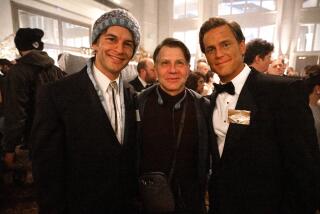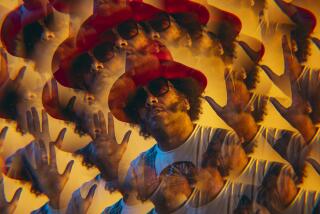Gay Culture Is the Ultimate Victim of AIDS
In Los Angeles a couple of weeks ago, I passed swarm after swarm of bicyclists whizzing down Pacific Coast Highway who had come all the way from San Francisco on an AIDS charity ride. Later, I met someone who had been to the triumphal concluding ceremonies. When the riderless bicycle--reprising the riderless horse at big-time national obsequies--was wheeled in, there wasn’t a dry eye in the house.
The kitsch thing with the riderless bike sent me straight back to a chapter, “The Kitschification of AIDS,” in Daniel Harris’ savagely intelligent new book, “The Rise and Fall of Gay Culture.” Citing the famous Benetton ad of a man obviously dying of AIDS under a cheap print of Jesus calling from the Other Side while his parents clutch and sob, Harris observes that: “In a little over a decade AIDS has become so thoroughly commercialized that the marketing of compassion now sustains a number of flourishing cottage industries.”
Typical is Under One Roof, a gift store in San Francisco. This boutique carries an expensive selection of merchandise on the cutting edge of the epidemic: Keith Haring tote bags, T-shirts with the words “We’re cookin’ up love for people with AIDS,” “Awareness Watches” and teddy bears sporting red ribbons.
AIDS has become a veritable sanctuary for kitsch, from the panel in the AIDS quilt featuring an envelope addressed to “A Better Place” to Andre Durand’s painting “Votive Offering,” depicting, in Harris’ words, “an ethereal Princess Di surrounded by saints, placing her hands on an emaciated PWA [person with AIDS] while dying men in the hospital beds around her strain at their dripping IVs like lurid scarecrows pleading to touch the hem of her skirt.” From Di to Whoopi Goldberg, the epidemic has offered celebs a marvelous way to advertise their generosity.
There’s a decent reason for the role show business has played: Washington wasn’t doling out money. Desperate for private contributions during the Reagan-Bush years, activists turned the disease into a commodity, into what might be called the AIDS “product,” introduced through a blitz of kitschy public appeals.
In Harris’ view, this kitschification was provoked by “our urgent need to render its victims innocent. To thwart the demonization of gay men by neoconservatives, we have attempted to whitewash sexual practices that mainstream America finds socially unacceptable.” This has led to increasingly infantile AIDS propaganda. AIDS victims are featured either as weak and deserving of pity, or as indomitable.
The AIDS quilt “exudes a spurious aura of artsy-craftsyness, of kindly old grannies in bifocals and bonnets stitching up a storm . . . Nostalgia is thus a fundamental ingredient of AIDS kitsch, the longing for . . . a disease-free never-never land.”
Folk art also offers a useful substitute for the retributive rhetoric of Christianity, and the sentimental conventions of folk art consort tightly with the therapeutic secularism of AIDS-related rites. The hucksters of the human potential movement have had a field day, leaping over the grim realities into a spirit of fuzzy euphoria in which AIDS is presented as a beneficial learning experience, or as one PWA put it in the San Francisco Examiner, as “the most wonderful thing that ever happened in my life.”
In other words, there’s nothing self-empowerment can’t achieve. But a subculture strengthened by this optimistic philosophy of self-assertion was pathetically ill-equipped to accept a cruel necessity of life that contradicted one of the chief intellectual tenets of gay liberation.
But why does Harris regard this kitschification with such splenetic distaste? After all, the cultural strategy, quilting bees and all, did allay homophobia.
Harris is making a profounder point. “The less marginal we become,” Harris writes, “the more we romanticize our marginality as an outlawed group, a status that is now largely the self-flattering fiction of a minority well on its way to achieving complete social integration.”
He sees the acceptance of homosexuals into the mainstream as spelling the impending disappearance of specifically gay culture, which constitutes “a significant loss, not just for gay people, but for American culture.” The emotional frustration caused by homophobia pushed gays into the pursuit of culture, Harris argues. As oppression decreases, “we will feel less inclined to assert ourselves as the proverbial tastemakers of our society” whose cultural life “will be deprived of a major source of artistic and intellectual energy as homosexuals are finally integrated.”
Paradoxically the kitschification of AIDS has hastened this process. I don’t imagine Harris is sad to bid adieu to homophobia, but the ironies in its banishment are sourly bracing, the way kitsch never is.
More to Read
Sign up for our Book Club newsletter
Get the latest news, events and more from the Los Angeles Times Book Club, and help us get L.A. reading and talking.
You may occasionally receive promotional content from the Los Angeles Times.








